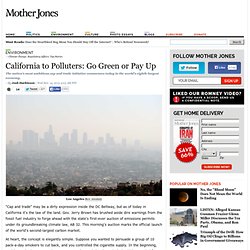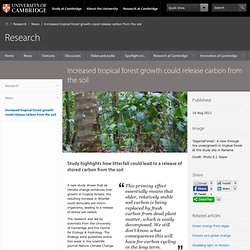

Hurricane Sandy vs. Katrina Infographic Examines Destruction From Both Storms. Over 100 people have died in the U.S. alone so far from Hurricane Sandy, and concerns are mounting that with hundreds of thousands still without power in frigid temperatures, the death toll will continue to climb.

As the East Coast examines the destruction, comparisons have been made to other catastrophic storms. Hurricane Katrina, which ravaged the Gulf Coast in 2005, killed over 1,800 people and cost nearly $125 billion. California to Polluters: Go Green or Pay Up. Los Angeles Ben Amstutz.

A solution to reverse Africa's growing deserts. I've often said that the most sophisticated "green" technology on the planet is the humble tree.

Trees sequester carbon, fix nitrogen into the soil, create organic compost, prevent erosion and encourage rain, while providing sustainable crops, shape, lumber and even fuel. The single most important activity on the planet (I believe) is planting trees, a fact backed up by the latest McKinsey study on abating the effects of global warming. But there is a problem. Reforestation efforts in denuded lands such as Africa, Mexico, India and China have never been taken seriously as a means to abate climate change because young saplings are very difficult to establish. The Impact Of EV Solar Charging Stations On Our Health (infographic) Jon Young — First Vertical Farm Opens in Singapore. Vegetables grown in multi-level troughs at Sky Greens farm.

Can 1 miracle plant solve the world's 3 greatest problems? If someone were to tell you that they had a technology — a weed actually — that could sequester huge amounts of carbon permanently while lifting villagers out of poverty by providing both protein-rich food and super-insulated building materials, you might start to wonder if they were, well, smoking a different weed.

But it appears that one retired building contractor, Bill Loftus, has actually come upon a brilliant application of the fast-growing, carbon-sucking plant known as Kenaf. Kenaf is in the Hibiscus family and is thus related to both cotton and okra. Originally from Africa, this 4,000-year-old crop was used for its fiber. It has the astonishing ability to grow up to 14 feet in one growing season, yielding 6-10 tons of fiber per acre and making it a great source of pulp for paper. But researchers have also discovered (PDF) a corresponding ability of Kenaf to inhale huge quantities of our most abundant global warming gas — CO2. But its not enough to simply absorb CO2. Press Releases August 2008 - Cutting Fossil Fuel Subsidies Can Cut Greenhouse Gas Emissions Says UN Environment Report. Cutting Fossil Fuel Subsidies Can Cut Greenhouse Gas Emissions Says UN Environment Report Meanwhile New Assessment of Clean Development Mechanism Shows Climate-Friendly Energy Projects Achieving Lift-Off in Sub Sahara Africa Accra/Nairobi, 26 August 2008 - Scrapping fossil fuel subsidies could play an important role in cutting greenhouse gases while giving a small but not insignificant boost to the global economy a new report by the UN Environment Programme (UNEP) says.

The report challenges the widely held view that such subsidies assist the poor arguing that many of these price support systems benefit the wealthier sections of society rather than those on low incomes. They are also diverting national funds from more creative forms of pro-poor polices and initiatives that are likely to have a far greater impact on the lives and livelihoods of the worse-off sectors of society. Globally around $300 billion or 0.7 per cent of global GDP is being spent on energy subsidies annually. Increased tropical forest growth could release carbon from the soil. A new study shows that as climate change enhances tree growth in tropical forests, the resulting increase in litterfall could stimulate soil micro-organisms, leading to a release of stored soil carbon.

The research was led by scientists from the University of Cambridge and the Centre for Ecology & Hydrology. The findings were published online this week in the scientific journal Nature Climate Change. The researchers used results from a six-year experiment in a rainforest at the Smithsonian Tropical Research Institute in Panama, Central America, to study how increases in litterfall - dead plant material such as leaves, bark and twigs which fall to the ground - might affect carbon storage in the soil. IBM Researchers Develop Highly Recyclable, Biodegradable Plastic.
It's not just oil spills: Our oceans are under more stress than they can handle. I saw on the news today that a new tropical storm is forming in the Gulf of Mexico.

When you’re from New Orleans, that always grabs your attention. It looks like the Crescent City will be spared – models show the storm more likely drifting east toward Florida — but on the other hand it seems certain that one of these days another hurricane will bear down on Louisiana. And when it does, there’s a good chance it will be every bit as powerful as Katrina, maybe stronger. Masdar City: World's most Sustainable City. An artist's rendering of Masdar City Smack dab in the middle of the desert is the location of one of the world’s greenest cities.

Masdar City is located in Abu Dhabi, UAE. The city is actually still in the early stages of being developed, but several buildings are fully operational, including the Masdar Institute of Science and Technology. The Masdar Institute of Science and Technology. Arctic environment during an ancient bout of natural global warming. Scientists are unravelling the environmental changes that took place around the Arctic during an exceptional episode of ancient global warming.

Newly published results from a high-resolution study of sediments collected on Spitsbergen represent a significant contribution to this endeavour. The study was led by Dr Ian Harding and Prof John Marshall of the University of Southampton’s School of Ocean and Earth Science (SOES), based at the National Oceanography Centre, Southampton. Around 56 million years ago there was a period of global warming called the Paleocene–Eocene Thermal Maximum (PETM), during which global sea surface temperatures increased by approximately 5°C.
Wik-Bee Leaks: EPA Document Shows It Knowingly Allowed Pesticide That Kills Honey Bees. The world honey bee population has plunged in recent years, worrying beekeepers and farmers who know how critical bee pollination is for many crops. A number of theories have popped up as to why the North American honey bee population has declined--electromagnetic radiation, malnutrition, and climate change have all been pinpointed. Now a leaked EPA document reveals that the agency allowed the widespread use of a bee-toxic pesticide, despite warnings from EPA scientists. The document, which was leaked to a Colorado beekeeper, shows that the EPA has ignored warnings about the use of clothianidin, a pesticide produced by Bayer that mainly is used to pre-treat corn seeds.
The pesticide scooped up $262 million in sales in 2009 by farmers, who also use the substance on canola, soy, sugar beets, sunflowers, and wheat, according to Grist.